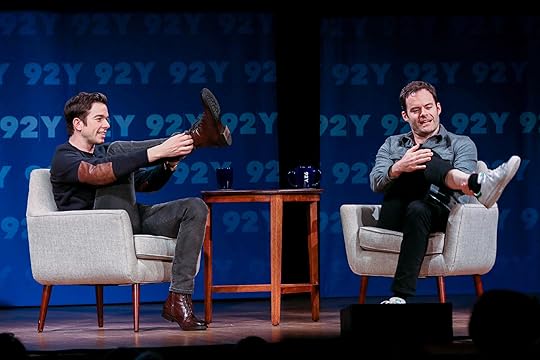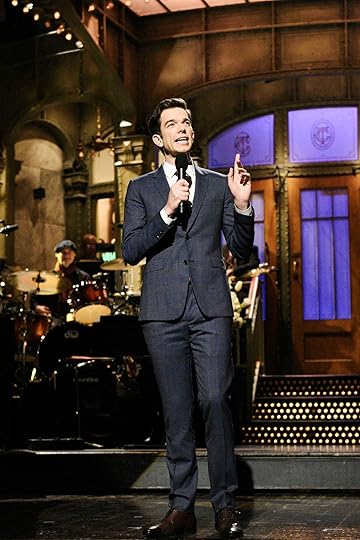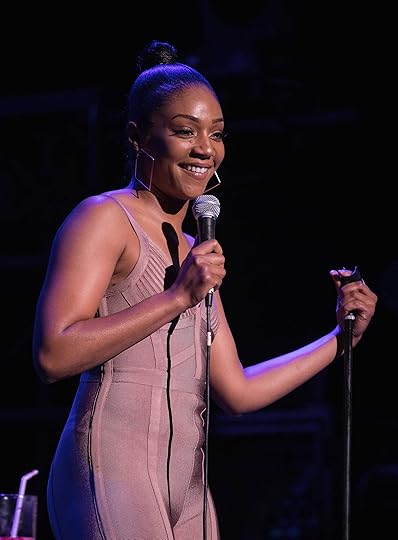Unpacking the (Fascinating) State of Style in Comedy
In what have to be some of the most joyful 93 minutes on YouTube, comedians John Mulaney and Bill Hader shoot the shit on the stage of New York’s 92nd Street Y. (I know about the video because I was there, one of many rapt audience members, having clawed my way uptown in torrential rain on Mother’s Day.) If you watch the recording, you might notice that neither of their outfits veer off the grayscale, save for a few brown elbow patches. And at one point, in the midst of a bit that would be zapped of its magic if I transcribed it here, Mulaney inspects the white Stan Smiths on Hader’s feet and concludes, in his somehow lilting deadpan: “There’s like only four things people who write comedy can wear, and that’s it: Adidas, New Balance, khaki, jean.” With Mulaney and Hader looking exceptionally regular on stage, the joke lands, but beyond this room, I’m not sure it rings true.
 Photo by Maricela Magana / Michael Priest Photography.
Photo by Maricela Magana / Michael Priest Photography.To the contrary: The style of comedians today embraces and reflects all the idiosyncrasies of coastal America’s zeitgeist. Whereas in the past, a comic’s means of expressing their identities was fairly limited to their material and how they looked while performing it, they can now wield much more influence as a visual presence. This is clearly a product of our era, the one that rewards the person with the strongest personal brand, feeds an appetite for comedy on streaming and social networks alike, and entertains an audience that (rightfully) demands to see itself represented on screen—and this shift has had eye-catching ripple effects.
Pete Davidson, my liege, is but one obvious example of a figure seizing upon this moment. But these days, there’s room for everyone: yes, for John Mulaney, who often looks like he’s stepped right out of a 1950s Barbasol ad, but also for folks like Julio Torres, he of the luminous and metallic otherworldly appeal; post-SNL Maya Rudolph with her long, frothy silhouettes; Tim Robinson in Eric Emanuel shorts; and Greta Lee, oft seen in sublime, slime greens and designer fleece. And sure, comedy has always been accompanied by its fair share of merch, but Aidy Bryant charts new territory as a designer at the helm of her own plus-size clothing line, Pauline.
 Photo via Getty Images.
Photo via Getty Images.It’s not that comedy’s been heretofore devoid of style. For every neutral Bill Maher ensemble, there’s a kernel of imagination to be found elsewhere in the history of American comedy. Take, for instance, Andy Kaufman’s outfit from his Mighty Mouse performance on the first-ever episode of Saturday Night Live. This might be the closest comedy ever gets to Phoebe Philo’s Céline. Mid-rise white jeans, a light blue button-down over a black turtleneck, and a plaid blazer—it sounds pretty standard, but there’s something electrifying in its simplicity. It’s almost as if Kaufman made himself into a time-defying scarecrow so that the electric current of Mighty Mouse can run through him. The simplicity here isn’t employed to skirt attention or deemphasize his appearance: Kaufman’s clothes align with his concept. The form fits the content.
Dressing for the Special
Do you notice the clothes when you watch comedy specials? Watching Adam Sandler’s 100% Fresh, I could barely pay attention to the jokes and songs, because all I could see was a supercut of every outfit Sandler wore in one year: a Champion varsity jacket, an illegible graphic tee in a New York Mets color scheme, a dusty pink short-sleeve button-down shirt. In Jenny Slate’s recent Stage Fright, she inhabits a black two-piece satin set from Nili Lotan (“Death will come for all of us; I’m dressed for it”) and what look like Kyoto Tango bracelets on one wrist. Courtesy of My Next Guest Needs No Introduction, the compelling visual of a bearded and bespectacled David Letterman, styled by Kanye West in head-to-toe Yeezy, has stayed with me long after I closed my browser window. A recent development, Seth Meyers in Lobby Baby could sell a million navy sweaters.
 Photo via Getty Images.
Photo via Getty Images.And then there are comedians like Ali Wong, Tiffany Haddish, and Amy Schumer, bellwethers of a shift in how women comedians dress for standup, embracing more traditionally feminine silhouettes instead of something more nondescript. Continuing the project of challenging gender norms, Wong and Schumer have also worn dresses while performing pregnant: Wong takes the stage for Baby Cobra in a tight leopard bandage dress, while Schumer used her flowy minidress to reveal the bandage she’d placed over her pregnant belly-button in Growing. Comedians today have a real knack for optics, because part of their job requires keen observation and sensitivity. They know the way they speak can undercut the image before you, and they can pull that lever when they need.
I definitely thought twice about the clothes when I watched Aziz Ansari’s recent special. Ansari recognizes this special as his first widely disseminated opportunity to address the babe.net controversy that enshrouded him in 2018, and he contextualizes it within a conversation about outrage culture and performative wokeness. Seated on a stool in the center of the stage, he wears a Metallica “Ride the Lightning” t-shirt, grey skinny jeans, and black Van-like slip-ons with a skeletal graphic of feet printed on the canvas, hovering above where Ansari’s actual feet are, like an X-ray.
What is Aziz Ansari trying to convey with this outfit? What could a close reading of what Ansari wears reveal? There’s the comfort of wearing a soft, vintage t-shirt featuring the band you love during a trying and vulnerable performance, and yet there’s something sort of defensive, guarded, and intimidating about wearing a heavy metal t-shirt, too. His shoes telegraph the literal idea of transparency, and they also humanize him a bit, with an understated, spooky reminder that he’s the same make and model as the other skeletons occupying the Brooklyn Academy of Music. How intentional these choices are, we’ll never know, but Ansari torpedoes through this special dressed as a vehicle for political commentary and for public relations.
Taking Cues From Joan Rivers
Curious about the tensions between forming your own identity, personal brand, and stage presence, I reached out to Ziwe Fumudoh, a multihyphenate within the world of New York comedy. Fumudoh writes for a TV show, though on any given day she may go to the studio after work and voice-record for her music or an animation (she’s Kamala Harris on Cartoon President), after which she may do a show or two, and during some limbo time, she’ll shoot an Instagram video or write a viral tweet.
Fumudoh credits her predecessors with laying the groundwork for comedy’s crosspollination with fashion: “Richard Pryor, Eddie Murphy, and Joan Rivers all had distinct personal styles. Comedians have always had individualistic aesthetic senses of self.” But Fumudoh does note that the newly granted access we have to comedians’ daily lives makes it possible to see more expressions of style. “If Joan Rivers had an Instagram, you bet your behind you’d see iconic looks for days,” she says. “These legends paved the way for comedians like Patti Harrison, Cat Cohen, and myself to create fashion moments on a regular basis.”
View this post on Instagram
Leandra Medine's Blog
- Leandra Medine's profile
- 75 followers




